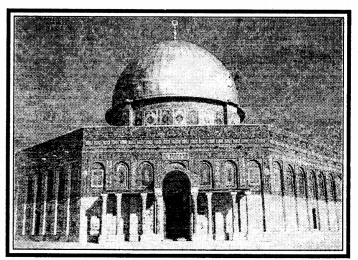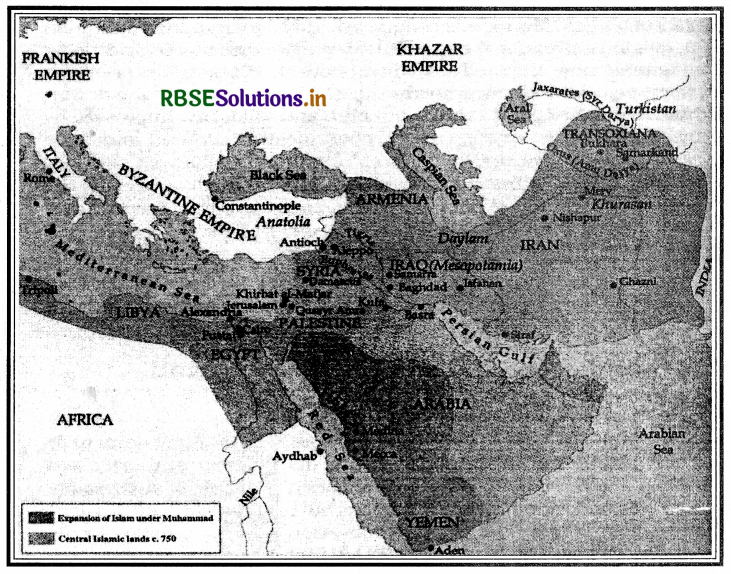RBSE Solutions for Class 11 History Chapter 4 The Central Islamic Lands
Rajasthan Board RBSE Solutions for Class 11 History Chapter 4 The Central Islamic Lands Textbook Exercise Questions and Answers.
RBSE Class 11 History Solutions Chapter 4 The Central Islamic Lands
RBSE Class 11 History The Central Islamic Lands Textbook Questions and Answers
Answer in Brief:
Question 1.
What were the features of the lives of the Bedouins in the early 7th century ?
Answer:
(i) The Caliph’s soldiers, mostly Bedouins, settled in camp cities at the edge of the desert, such as Kufa and Basra, to remain within reach of their natural habitat as well as the caliph’s command.
(ii) The ruling class and soldiers received shares of the booty and monthly payments (ata).
(iii) The non-Muslim population retained their rights to property and religious practices on payment of taxes (kharaj andjiziya). Jews and Christians were declared protected subjects of the state (dhimmis) and given a large measure of autonomy in the conduct or their communal affairs.

Question 2.
What is meant by term ‘Abbasid revolution’ ?
Answer:
The term ‘Abbasid Revolution’ referred to the Dawa movement. This movement was initiated by Abu Muslim from Khurasan against the Umayyad dynasty. The Abbasid Revolution put an end to the Umayyad dynasty. By overthrowing Umayyadies the Abbasid dynasty came into throne in 750 CE.
Question 3.
Give examples of the cosmopolitan character of the states set up by Arabs, Iranians and Turks.
Answer:
(i) Arab empire was inhabited by these tribes. Mainly the Muslims, the Christian and the Jew culture townshed under Arabs.
(ii) Muslim and Asian culture developed under the Iranian ruler.
(iii) The mixture of the fusion of Syrian, Indian, Iranian and Egyptian was observed during Turkish empire.
Question 4.
What were the effects of Crusades on Europe and Asia ?
Answer:
(i) In the first Crusade, soldiers from France and Italy captured Antiochin Syria and also claimed Jerusalem. Their victory marked by slaughter of Muslims and Jews.
(ii) The Muslim writers named their invasions (Invasions of Christian) as Frankish invaison who quickly established their influencies over these regions.
(iii) The Crusades left a deep impact on the aspects of Christain Muslim relations.
(iv) Influence of Crusades led to declination of Italination of mercantile which paved the way for the emergence of nation states.
(v) The Muslim states adopted harsher attitude toward their Christain attitudes.

Question 5.
How were Islamic architectural forms different from those of the Roman Empire ?
Answer:
Islamic Architectural Forms :
(i) The Islamic art right from Spain to Central Asia represents some basic architectural features such as horse shoe arches, bubois, domes, minarets, columns and open courtyard.
(ii) Religious buildings : Mosques, shrines and tombs were the greatest architectural symbols of Islamic world.
(iii) Another feature was the decorative forms of writing e.g., calligraphy and arabesque i.e., geometric and vegetal designs to decorate architecture and manuscripts.
(iv) The palaces were modelled on Roman and Sasanian architectural features e.g., the palace at Baghdad. They were richly decorated with sculptures, mosaics and paintings.
Roman Empire Architectural Forms :
(i) The Roman Emperors were great builders. They introduced two important architectural features - the arch and cupolas or domes.

The Dome of the Rock, is the earliest major work of Islamic architecture. It was Created as a monument to the Muslim presence in the city of Jerusalem and acquired a mystical association connected with the Night Journey of the Prophet to Heaven (miraj).

(ii) Art of painting murals was highly developed so much so that some of their murals practially covered the whole wall.
(iii) Their buildings were multistoried with one row of arches standing over another, e.g., Pompeys Theatre.
(iv) Round arches were used in city gates, bridges, buildings and monuments of victory.
(v) The spread of Christianity gave a new impetus to the buildings of the Roman Empire. St. Sophia in Constantinople and buildings in Jerusalem stand witness to the Roman architectural skills.
Question 6.
Describe a journey from Samarqand to Damascus to the referring to the cities on the route.
Answer:
It is an activity base question and it can be solved through map activity. Map given on NCERT Page 82, trace out the route followed from Samarqand to Damascus. 
